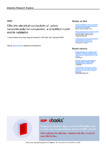Effective electrical conductivity of carbon nanotube-polymer composites: a simplified model and its validation
| dc.contributor.author | Jang, Sung-Hwan | |
| dc.contributor.author | Yin, H | |
| dc.date.accessioned | 2018-12-07T13:00:00Z | |
| dc.date.available | 2018-12-07T13:00:00Z | |
| dc.date.issued | 2015-04 | |
| dc.identifier.issn | 2053-1591 | |
| dc.identifier.issn | 2053-1591 | |
| dc.identifier.other | ARTN 045602 | |
| dc.identifier.uri | http://hdl.handle.net/10026.1/13000 | |
| dc.description.abstract |
Asimplified model is presented to predict the effective electrical conductivity of carbon nanotube (CNT)-polymer composite with different material proportions, which is validated by the experiments of multi-walled CNT/polydimethylsiloxane (PDMS) composites. CNTs are well dispersed in aPDMS matrix, and the mixture is then cured and cast into thin films for electrical characterization. The CNTs are assumed to be statistically uniformly distributed in thePDMSmatrix with the three-dimensional (3D) waviness. As the proportion of CNTs increases to a certain level, namely the percolation threshold, the discrete CNTs start to connect with each other, forming a 3Dnetwork which exhibits a significant increase of effective electrical conductivity. The eight-chain model has been used to predict the effective electrical conductivity of the composite, in which the contact resistance between CNTs has been considered through the Simmons' equation. The eight-chain network features can be significantly changed with the modification to mixing process,CNTlength and diameter, andCNT clustering and curling. AGaussian statistics-based formulation is used to calculate the effective length of a singleCNTwell dispersed in the matrix. The modeling results of effective electrical conductivity agree with the experiments very well, which are highly dependent on a contact resistance between CNTs and the waviness of the CNTs. The effect of inner-nanotube distance and diameter of CNTs on the effective electrical conductivity of the CNT/PDMS composite is also discussed. | |
| dc.format.extent | 045602-045602 | |
| dc.language.iso | en | |
| dc.publisher | IOP Publishing | |
| dc.rights | Attribution 4.0 International | |
| dc.rights | Attribution 4.0 International | |
| dc.rights | Attribution 4.0 International | |
| dc.rights | Attribution 4.0 International | |
| dc.rights | Attribution 4.0 International | |
| dc.rights.uri | http://creativecommons.org/licenses/by/4.0/ | |
| dc.rights.uri | http://creativecommons.org/licenses/by/4.0/ | |
| dc.rights.uri | http://creativecommons.org/licenses/by/4.0/ | |
| dc.rights.uri | http://creativecommons.org/licenses/by/4.0/ | |
| dc.rights.uri | http://creativecommons.org/licenses/by/4.0/ | |
| dc.subject | carbon nanotube | |
| dc.subject | polymer | |
| dc.subject | electrical conductivity | |
| dc.subject | eight-chain model | |
| dc.subject | gaussian chain | |
| dc.title | Effective electrical conductivity of carbon nanotube-polymer composites: a simplified model and its validation | |
| dc.type | journal-article | |
| dc.type | Journal Article | |
| plymouth.author-url | https://www.webofscience.com/api/gateway?GWVersion=2&SrcApp=PARTNER_APP&SrcAuth=LinksAMR&KeyUT=WOS:000370007300027&DestLinkType=FullRecord&DestApp=ALL_WOS&UsrCustomerID=11bb513d99f797142bcfeffcc58ea008 | |
| plymouth.issue | 4 | |
| plymouth.volume | 2 | |
| plymouth.publication-status | Published online | |
| plymouth.journal | Materials Research Express | |
| dc.identifier.doi | 10.1088/2053-1591/2/4/045602 | |
| plymouth.organisational-group | /Plymouth | |
| plymouth.organisational-group | /Plymouth/Faculty of Science and Engineering | |
| plymouth.organisational-group | /Plymouth/REF 2021 Researchers by UoA | |
| plymouth.organisational-group | /Plymouth/REF 2021 Researchers by UoA/UoA12 Engineering | |
| dc.identifier.eissn | 2053-1591 | |
| dc.rights.embargoperiod | Not known | |
| rioxxterms.versionofrecord | 10.1088/2053-1591/2/4/045602 | |
| rioxxterms.licenseref.uri | http://creativecommons.org/licenses/by/4.0/ | |
| rioxxterms.type | Journal Article/Review |



